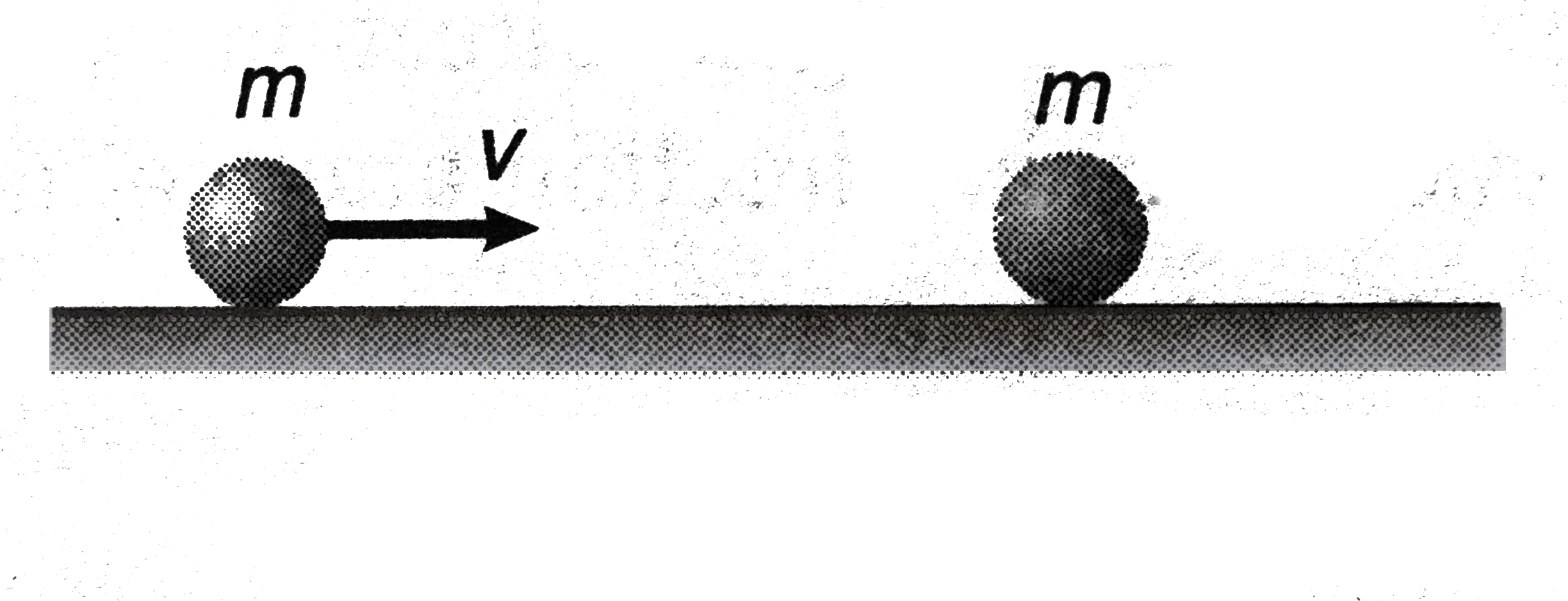Ball 1 collides directly with another identical ball 2 at rest. Velocity of second ball becomes two times that of 1 after collison. Find the coefficient of restitution between the two balls?
The correct Answer is:A, C
To solve the problem, we will follow these steps:
Step 1: Understand the Problem
We have two identical balls, Ball 1 and Ball 2. Ball 1 is moving with an initial velocity U and collides with Ball 2, which is at rest. After the collision, the velocity of Ball 2 becomes twice that of Ball 1.
Step 2: Define Variables
- Let the mass of each ball be m.
- Let the initial velocity of Ball 1 be U.
- Let the final velocity of Ball 1 after the collision be V1.
- Let the final velocity of Ball 2 after the collision be V2.
Given that V2=2V1.
Step 3: Apply Conservation of Momentum
Since no external forces are acting on the system, we can apply the law of conservation of momentum:
Initial Momentum=Final Momentum
The initial momentum is:
mU+0=mU
The final momentum is:
mV1+mV2=mV1+m(2V1)=mV1+2mV1=3mV1
Setting the initial momentum equal to the final momentum:
mU=3mV1
Cancelling m from both sides (assuming m≠0):
U=3V1
Thus, we can express V1 in terms of U:
V1=U3
Step 4: Calculate the Coefficient of Restitution
The coefficient of restitution e is defined as:
e=Velocity of separationVelocity of approach
Velocity of separation after the collision:
Velocity of separation=V2−V1=2V1−V1=V1
Velocity of approach before the collision:
Velocity of approach=U−0=U
Substituting the values into the coefficient of restitution formula:
e=V1U
Now, substituting V1=U3:
e=U3U=13
Conclusion
The coefficient of restitution between the two balls is:
13
We have two identical balls, Ball 1 and Ball 2. Ball 1 is moving with an initial velocity U and collides with Ball 2, which is at rest. After the collision, the velocity of Ball 2 becomes twice that of Ball 1.
- Let the mass of each ball be m.
- Let the initial velocity of Ball 1 be U.
- Let the final velocity of Ball 1 after the collision be V1.
- Let the final velocity of Ball 2 after the collision be V2.
Since no external forces are acting on the system, we can apply the law of conservation of momentum:
The coefficient of restitution e is defined as:
The coefficient of restitution between the two balls is:
Topper's Solved these Questions
- CENTRE OF MASS, LINEAR MOMENTUM AND COLLISIONBOOK - DC PANDEYCHAPTER - CENTRE OF MASS, LINEAR MOMENTUM AND COLLISIONEXERCISE - Level 1 Assertion and Reason
15 Videos
- CENTRE OF MASS, LINEAR MOMENTUM AND COLLISIONBOOK - DC PANDEYCHAPTER - CENTRE OF MASS, LINEAR MOMENTUM AND COLLISIONEXERCISE - Level 1 Objective
42 Videos
- CENTRE OF MASS, LINEAR MOMENTUM AND COLLISIONBOOK - DC PANDEYCHAPTER - CENTRE OF MASS, LINEAR MOMENTUM AND COLLISIONEXERCISE - Exercise 11.5
4 Videos
- CENTRE OF MASS, IMPULSE AND MOMENTUMBOOK - DC PANDEYCHAPTER - CENTRE OF MASS, IMPULSE AND MOMENTUMEXERCISE - Comprehension type questions
15 Videos
- CIRCULAR MOTIONBOOK - DC PANDEYCHAPTER - CIRCULAR MOTIONEXERCISE - Medical entrances s gallery
19 Videos
Similar Questions
A ball P moving with a speed of v ms collides directly with another identical ball Q moving with a speed 10ms' in the opposite direction. P comes to rest after the collision. If the coefficient of restitution is 0.6 the value of v is
View SolutionBall 1 collides with another identical ball at rest. For what value of coefficient of restitution e, the velocity of second ball becomes two times that of 1 after collision? _____.
View Solution
Knowledge Check
A ball of mass m moving at a speed v collides with another ball of mass 3m at rest. The lighter block comes to rest after collisoin. The coefficient of restitution is
A(a) 12B(b) 23C(c) 14D(d) None of theseTwo identical balls are dropped from the same height onto a hard surface, the second ball being released exactly when the first ball bollides with the surface. If the first ball has made two more collisions by the time the second one collides. Then the coefficient of restitution between the ball and the surface satisfies :
Ae>0.5Be=0.5Ce=√3−12De<√3−12Ball 1 collides with an another identical ball 2 at rest as shown in figure. For what value of coefficient of restitution e, the velocity of ball 2 becomes two times that of ball I after collision?
 A13B12C14D16
A13B12C14D16
A ball of mass m moving with velocity u strikes another identical ball at rest. Find the velocities of the balls after the collision if the coefficient of restitution is e and the collision is head -on. Also , calculate the loss in K.E.
View SolutionOn a frictionless surface, a ball of mass m moving at a speed v makes a head on collision with an identical ball at rest. The kinetic energy of the balls after the collision is 3/4th of the original. Find the coefficient of restitution.
View SolutionA ball of mass m moving at speed v makes a head on collision with an identical ball at rest. The kinetic energy of the balls after the collision is 3/4th of the original. Find the coefficient of restitution.
View SolutionA ball of mass m moving at a speed v makes a head on inelastic collision with an identical ball at rest. The kinetic energy of the balls after the collision is 34th of the original. Find the coefficient of restitution.


View SolutionA ball collides directly with another ball at rest and is brought to rest by the impact. If half of the initial kinetic energy is lost in the impact, then the coefficient of restitution is
View Solution
